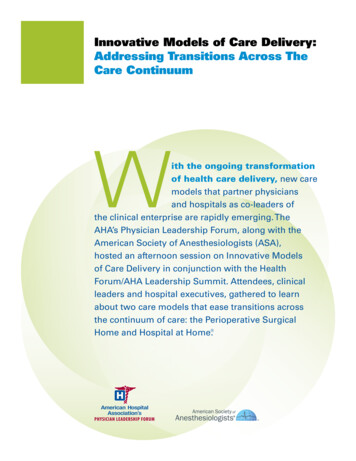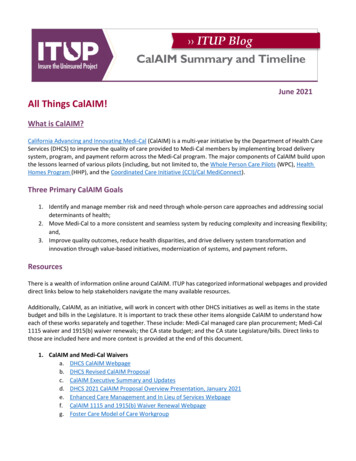
Transcription
Innovative Models of Care Delivery:Addressing Transitions Across TheCare ContinuumWith the ongoing transformationof health care delivery, new caremodels that partner physiciansand hospitals as co-leaders ofthe clinical enterprise are rapidly emerging. TheAHA’s Physician Leadership Forum, along with theAmerican Society of Anesthesiologists (ASA),hosted an afternoon session on Innovative Modelsof Care Delivery in conjunction with the HealthForum/AHA Leadership Summit. Attendees, clinicalleaders and hospital executives, gathered to learnabout two care models that ease transitions acrossthe continuum of care: the Perioperative SurgicalHome and Hospital at Home .
FacultyTerry Belmont, MPH, Chief Executive Officer & Associate Chancellor, UC Irvine Health,Orange, CAMichael Caravelli, MD, The Center: Orthopedic and Neurosurgical Care and Research,Bend, ORJohn R. Combes, MD, Senior Vice President, AHA, Chicago, ILKathy Davis, RN, SVP and Chief Nursing Officer, Presbyterian Healthcare Services,Albuquerque, NMZeev N. Kain, MD, MBA, Professor and Chair of Anesthesiology, Associate Dean for ClinicalOperations and Acting CMO, UC Irvine Health, Orange, CAPeggy L. Naas, MD, MBA, Orthopedic surgeon physician consultant, Chanhassen, MNMike Schweitzer, MD, MBA, Vice President of Healthcare Delivery System Transformation,VHA Southeast, Tampa, FLJeff Selberg, Executive Director, Peterson Foundation, New York, NYStanley Stead, MD, MBA, Vice President, Professional Affairs, ASA, Encino, CA 2015 American Hospital Association
Keynote AddressInnovative Care DeliveryJeff Selberg, executive director of the Peter G. Peterson Foundation, setthe stage for the day, discussing how new models fit in with the changingenvironment of health care. Mr. Selberg spoke about the state of health carein the U.S., three features of successful models and how to “install” newmodels of care.The Peterson Foundation’s mission is to increasepublic awareness on the nature and urgency ofkey economic challenges threatening America’sfuture and to accelerate action. It aims todevelop and grow initiatives fostering better carefor lower cost by being a catalyst for change.In close collaboration with others, the PetersonFoundation hopes to speed improvement bydiscovering and spreading the adoption ofbreakthrough innovations that significantlyimprove health care outcomes while loweringcost. The Peterson Foundation’s strategy is toidentify high-impact, proven solutions in theU.S., develop conditions for change andfacilitate broad-scale adoption.Health Care in the U.S.While at the Institute for HealthcareImprovement (IHI), Mr. Selberg would welcomea steady stream of leaders from high performinghealth systems from around the world eager tolearn from U.S. health care. Given the U.S.’slower ranking in overall health among developednations, he often asked why. Most pointed to the12pockets of excellence they wanted to learn aboutand bring back to their respective countries.While the U.S. health care system has pocketsof excellence, there is room to improve thevalue proposition. Allan Detsky1 wrote, “ManyAmericans are aware that the United Statesspends much more on health care than any othercountry in the world. But fewer people knowthat the health of Americans—by manydifferent measures—is actually worse than thehealth of citizens in other wealthy countries.”For the amount of money spent on health care inthe U.S. our outcomes should be better.The U.S. has improved upon healthy-lifeexpectancy over the past two decades, but therate of improvement is slower than the other33 countries that make up the Organizationfor Economic Cooperation and Development(OECD). In 1990, the U.S. ranked 14 out of 34in healthy-life expectancy. In 2010, the U.S.fell to 26. Further, of the 17 highest incomecountries in the world, the U.S. has the highestrate of infant mortality and the lowest chance ofsurviving to age five.2 Detsky, A. (2014 June 11). Why America is losing the health race. New Yorker. National Research Council and Institute of Medicine. (2013). U.S. health in international perspective: shorter lives, poorer health.3
In addition to the statistical measures puttingU.S. health care on the low end of the performance spectrum, U.S. health care delivery isoften seen as unwilling or unable to keep pacewith advancing technology and societalchanges. Other industries, such as banking andretail, have been able to adapt to changes in theenvironment driven by consumer expectations.As the Institute of Medicine (IOM) reportedin Best Care at Lower Cost: The Path toContinuously Learning Health Care in America:If banking were like health care,automated teller machine transactionswould take not seconds but perhapsdays or longer as a result of unavail-4able or misplaced records. If homebuilding were like health care,carpenters, electricians and plumberseach would work with different blueprints, with very little coordination If airline travel were like health care,each pilot would be free to design hisor her own preflight safety check, ornot to perform one at all. (p. 5-6)Despite all of these flaws, Mr. Selberg indicatedthere is hope. There are opportunities to improvehealth care, to develop dreams into a vision andfinally a vision into a reality. One method issearching out those alternative care models thathave both medical and social service attributes
and identifying the features that drive highperformance. Successful care should be customized based on the partnership between patientand clinician to foster shared decision making.Features of ExcellenceThe Peterson Foundation is collaborating withStanford University to identify, disseminate,replicate and scale features of exceptionallyhigh-value mainstream U.S. health care models.The first phase of the project focuses on primarycare physician practices who had upper quartileperformance for the National Committee onQuality Assurance (NCQA) HEDIS measuresand lower quartile performance for “all in” percapita costs metrics. As part of the project, theteam conducted site visits and interviews withphysicians, care providers and patients. Fromthis research, three “feature bundles” ofsuccessful models emerged: patient interactions,eco-system interactions and practice organization.Patient InteractionsA hallmark characteristic of a high-valuesystem is the ability to establish deep and realconnections with patients and maintainingcontinuity of care no matter where the patientis in the health care system. Successful systemshave a shared decision-making approach withpatients, as well as a deep connection. Theyseek out feedback from patients, and translatecriticisms into real improvements.Eco-system InteractionsHigh-value systems try to do as much as theycan themselves. They conserve resourcesconscientiously – developing and adhering toguidelines, as well as being mindful of tests andtreatments in order to prevent duplication andavoidable harm.Practice OrganizationA high-value system utilizes staff well,capitalizing on strengths and promoting staffinternally to more challenging roles with greaterresponsibilities. Workstations are bee hives, anddelivery of care is a team effort.Additional and more detailed informationregarding the three features of successful modelswill soon be shared by Stanford’s Center forClinical Excellence Research. The PetersonFoundation and Stanford will disseminate thefindings and build awareness of the models andthen work to develop pilot projects to “install”the key features. Using the results of the pilotprojects, they plan to develop a change packagethat can be implemented nationwide.5
“Installing” Effective CareModelsOnce successful features of innovative caremodels and practices are identified, they need tobe “installed.” The concept of “install” is meantto be provocative. Installation must be driven bya performance based culture as well as systemsand processes that support the features bundle.Installation consists of three key strategies:building will, harvesting ideas, and execution.Building will is establishing an environment ripefor improvement. Within such an environment,ideas can be harvested and executed. The threecomponents of installing successful featuresmust occur at every level and throughout theorganization.6Building WillBuilding will is fostering alignment aroundstrategy, process and purpose, and about howand why disruption should occur. There must beconversation at every level of the organizationabout alternative models, incentives, and datatransparency.Harvesting IdeasSuccessful installation of effective care modelscannot stop at building will. Models identifiedcan be focused on a condition like diabetes, atype of patient like a frail elder, or a setting likean intensive care unit or a clinic. Examples ofnew models might include patient-centeredmedical homes, building capacity in primarycare to integrate behavioral health and chronic
disease management, and integrating telemedicine with home care while engaging consumersto enable self-care.ExecutionDeming’s Theory of Profound Knowledge is auseful tool to develop an installation strategy.The theory has four parts: appreciation for asystem, knowledge about variation, theory ofknowledge, and psychology. The first step is todevelop a deep knowledge of the system thatmust be changed or disrupted. Paul Batalden,MD, renowned health policy expert, coined thephrase, “every system is perfectly designed toget the results it gets.” This provides context tothe definition of insanity, which is doing exactlythe same thing and expecting a different result.The second step is to establish the metrics thatwill measure the results achieved. You cannotmanage what you don’t measure. Metrics alsoenable variation analysis, which is essential todetermine if changes to the system resulted inimproved results. The third step employs theconcept of learning through application. Demingchampioned the Plan-Do-Study-Act (PDSA)cycle as a systematic and dynamic process oflearning through doing. The key is to make thechanges small enough to be willing to test themrather than large scale changes that constitutetoo much risk to actually apply. Finally, onemust understand the human factor or psychologyof change. Disrupting systems also meansdisrupting the people who manage them.Managing requires a significant investment incommunication to elicit the level of cooperationrequired in any improvement process.Health care is a vital sector of the U.S.economy that must improve its value proposition. Performance outcomes as a nation need toimprove, but much can be learned from thepockets of excellence that exist. Features ofhigh-value systems, such as patient interactions,eco-system interactions, and practiceorganization, need to be installed by buildingwill, harvesting ideas, and finally, execution.7
The Perioperative Surgical Home:Setting the StageStanley Stead, MD, ASA’s vice president, professional affairs, introducedthe Perioperative Surgical Home (PSH) by describing it as a coordinatedoptimization of patient transitions from the decision to operate throughfull recovery.Using data from the Centers for Medicare &Medicaid Services, Dr. Stead demonstrated thevast variability in cost per beneficiary across thecountry. He posited that variability is largely dueto improper preparation of patients and a lackof or inconsistent follow up. Once a decision is8made to operate, patients should be properlyprepared and assessed to determine the bestcourse of treatment that will provide the mostsuccessful surgical outcome and the bestrecovery path. While addressing inpatient lengthof stay is important in managing cost, post-
The Perioperative Surgical Home:Perspectives Paneloperative care and care needed for clinicalcomplications result in the highest percentageof cost variations. Addressing the patient’spost-operative needs and readiness for homecare versus rehabilitation care can providesignificant savings, but these decisions must bepatient-centered to ensure optimal outcomes.The goal is not to eliminate all variation but toeliminate non-value-added variation.A PSH is patient-centric and requiresteam-based, coordinated work, and shareddecision-making built on the patient’s goals anddesired outcomes. With an aligned vision, eachteam member can contribute their knowledgeand expertise on meeting those outcomes. APSH moves an organization toward value-basedcare by aligning patients, physicians, acute andpost-acute care.Implementing a PSH requires many differentcomponents – most important, quality systemswhere metrics are measured, and integrationacross a variety of systems in the hospital.Health care delivery cannot be accomplished byone person, but rather requires a team effort.The continuum of care begins at home, andextends to the community through wellnesscenters, retail pharmacies, physician offices,diagnostic imaging, and urgent care centers, tothe hospital. Beyond the hospital are post-acutecare, home care and rehabilitation. Roughly45 percent of the cost associated with surgeryis in the post-acute phase. If improvements donot focus on the entire system nearly half of theopportunity is missed.CEO PerspectiveAs an introduction to the three perspectives onPSH, Terry Belmont, MPH, chief executiveofficer and associate chancellor, University ofCalifornia (UC) Irvine, stressed the urgency forchange.To respond proactively to the Affordable CareAct and adapt to market change, UC Irvineunderwent a strategic planning process totransform care delivery within their organization and strengthen the partnerships with otherproviders in the continuum. UC Irvine’s cultureof innovation and inclusion allowed theorganization to transform. That culture isfounded on a clear mission of excellence inpatient care, research and education and a visionto be among the top health care centers and9
one of the top academic institutions. One of theelements resulting from the strategic plan andtransformation is the PSH.Mr. Belmont likened implementing a new caremodel to surfing. One must stay far enoughahead of the wave to not get swallowed up, butnot get too far ahead and lose momentum. As aCEO, the challenge is to stay on the wave andnot go too far in front or too far behind.Surgeon PerspectivePeggy L. Naas, MD, MBA, emphasized theimportance of moving past professionaldivisions, as well as developing and adheringto standards so that daily performance runssmoothly and as planned rather than in a reactiveand chaotic manner.Surgeons, anesthesiologists, the care team andthe patient need to make decisions together.When surgeons and anesthesiologists10collaborate, a patient can be properly preoptimized (“pre-habbed”), minimizingunanticipated and unexpected complicationsor poor outcomes post-operatively. Becauseanesthesiologists and surgeons have the samegoals – the benefit of the patient – common carepathways ought to be developed. The patientmust always be the central focus for allcaregivers involved.Each specialty understands risk stratification,based on evidence, about what will jeopardizeor negatively influence the ability to deliveroutcomes. But it should not be assumed that theorthopedic surgeon’s specialized knowledge isthe same as the anesthesiologist’s. Common andshared knowledge are key to optimal outcomesfor all involved. Collaboration ensures individual characteristics of a patient are identified tobetter “pre-habilitate” and ultimately care forthe patient. “Pre-habilitation” of a patient ispurposefully and proactively mitigating the
factors that drive complications, expenses,readmission, and poor outcomes.No two patients are the same medically, norshare the same life circumstances. Whether ornot a patient receiving total joint replacementwill be discharged to a third-floor walk-upmatters. The goal should be not to eliminate allvariation, but to eliminate non-value addedvariation, or variation that is driven fromphysician or care provider personal proclivitiesor experiences. Non-value added variations thatcan and should be addressed include eliminatingcancellations, delays and waste. Minimizingsuch variation leads to increased productivityand allows for focused attention to variationswhich patients bring to the operative theater.Surgeons and anesthesiologists shouldcommunicate and plan cases together; however,sometimes rivalry and competition in theoperating room prevent good communication.Egos and individual needs must be put aside.There needs to be a clear line of sight and sharedpurpose, shared team performance measures anda transparent and predictive process with, andfor, the patient.Anesthesiologist PerspectiveMike Schweitzer, MD, MBA, VHA Southeast’svice president of Healthcare Delivery SystemTransformation highlighted the fact that careof patients – and cost to the system – extendsbeyond the four walls of the hospital. Dr.Schweitzer addressed three areas needingattention; pre-optimization, post-discharge andalignment.Pre-optimizationTraditionally, lab tests and consults arecompleted shortly before the surgery, identifyingpatient needs pre- and post-operatively. Thiscommon practice of flurried activity prior tosurgery does not, however, improve patientrecovery. Patients need to be pre-optimized,which occurs in the pre-operative stage. Preoptimization is not only medical managementaddressing issues such as anemia, nutrition orphysical therapy, it also addresses socialelements such as what resources the patient hasat home. Pre-optimizing a patient may includegetting a social worker or care manager involvedbefore the patient comes into the hospital.Coordination across the whole continuum ofpre-operative, intra-operative, post-operative andlong-term care is essential. A team, including theprimary care physician, surgeon and anesthesiologist must communicate with one another andwith the patient to develop a proper care plan.Pre-operative clinics can expand to postdischarge clinics. After identifying the mostmedically complex patients, completing riskstratification, working with care managers andsocial workers, it will be clear which patientswill require more intense post-dischargesupport.Post-dischargeThose who prepared the patient pre-operativelycan continue care post-discharge. When postoperative care occurs where pre-operative caretook place, there is no need for new people, ornew units, and cost is reduced.The appropriate post-operative setting forpatients must be considered. A skilled nursing11
facility is necessary in some instances while inothers, a hospital home health agency (HHA)may be viable. For example, hospitals mightexamine what the percentage of patients havingtotal joint replacements are being dischargedto nursing homes. If just a fraction of those canbe identified a few weeks prior to surgery andpre-optimized with resources so they can gofrom hospital to home with home health carethere is an opportunity to cut costs, as studieshave shown a HHA can be cost effective andreduce readmissions.AlignmentThe Patient Centered Medical Home (PCMH)was identified in the primary care literature in1967; however, it took another 45 years beforePCMH began to gain traction, primarily due tolack of payment support options. While bundledpayments seem to fit well with PSH, there aremany payment options to consider. Key to themodel is aligned incentives to fully manage allof the care, pre-operatively, intra-operatively,post-operatively and post-discharge.Beyond payment, successful establishment of aPSH lies in identifying champions: the physicianchampion, nurse champion and administrativechampion who will drive change forward,execute the performance improvement plan,understand project management, can drivefrom start to finish and make he ASA is embarking on a PSH nationalcollaborative of 45 health care organizationsfrom across the country, to learn together howto improve the patient experience before, duringand after surgery. Because buy-in and alignmentare so critical to successful implementation ofan effective care model, such as the PSH, thehealth care organizations involved in thecollaborative are represented by teams, withspecific champions identified. “The PSHlearning collaborative involves clinical andadministrative staff from health care facilitiesworking together to redesign their systems tobecome more patient-focused and efficient forpatients undergoing surgical procedures.”3 Thethree goals of the collaborative are to develop: care delivery models, payment models; and a toolkit to rapidly implement thedelivery and payment models foracademic, community and pediatrichospitals.
The Perioperative Surgical Home:From Concept to SuccessfulImplementationZeev N. Kain, MD, MBA, UC Irvine Health’s professor and chair ofanesthesiology, associate dean for clinical operations and acting chiefmedical officer, detailed a successful PSH model from the initial concept,through implementation, to ongoing monitoring of results at UC Irvine.Evident in his presentation was the importanceof honoring and respecting what has alreadybeen done, building innovation into the currentsystem, and then learning from the system. Keysto success include coordinating care, breakingdown barriers and working together as a team.The PSH at UC Irvine is a multi-departmentalinitiative aimed at transforming surgical careby improving quality, increasing patient andprovider satisfaction and reducing cost of care.Pre-operative, intra-operative, post-operativeand post-discharge stages are separate systemsin the perioperative process. Many people workin each phase, and prior to the implementationof the PSH, there was a lack of communicationwhich often resulted in disjointed care. Thehigh variability in care leads to delays andinefficiencies, high cost, dissatisfied patientsand suboptimal outcomes. To address thediscontinuity of communication and care UCIrvine identified champions – the chair of thedepartment of orthopedic surgery, the chiefoperating officer, and the chief of anesthesiology– to spearhead the new model of care. As afirst stage in the project, all stakeholders wereidentified and brought together in weeklymeetings. These included not only anesthesiologists, surgeons and nurses but also hospitalists,decision support experts, nutrition experts, ITsupport, case management and others. The teamwas organized into the various phases of thesurgical journey and all team leaders underwenttraining in LEAN Six Sigma.They also established a PSH advisory board,including members of the C-suite as well assteering committees, oversight committees,task forces and teams. In order for change tooccur, communication within and among thesestructures was essential. A dashboard wasdeveloped that executives look at once a quarterfor specific services lines of the PSH. Thedashboard includes pre-operative, intra-operativeand post-operative measures, but also businessand process measures.After one year and 300 patients, metrics for thePSH at UC Irvine include unplanned 30-dayreadmissions at 0.5 percent, cancellation rateat 0.5 percent and on-time first case starts at90.9 percent.13
A PSH has to be adapted to the localenvironment, and be an organic process. ThePSH goals at UC Irvine are closely aligned tothose of the hospital. If change management isnot based on the organization and culture, it’snot going to happen.14
The Perioperative Surgical Home:Health Transformation FellowshipMichael Caravelli, MD, The Center: Orthopedic and Neurosurgical Careand Research, shared how to get a PSH started by establishing goals that arepatient-centered, evidence-based, aim to reduce practice variation and arebuilt within a system of accountability.St. Charles Health SystemSt. Charles is an integrated delivery systemproviding quality, evidence-based care across thetri-county area of Bend, Oregon. Historically,the system operated with the classic fragmentedcare model – less than optimal communicationand limited provider alignment. There canoften be disconnect between patients and theirprimary care physician following the decisionto operate. Cost of service and incidence ofcomplication are both high which is frustratingfor care providers, patients and family. Finally,there are incomplete transitions to and fromperioperative surgical care to a medical homeor primary care, sometimes accompanied bycomplications.Perioperative Surgical HomeEarly StagesIn January 2013, St. Charles embarked on theprocess of establishing a PSH and building thewill necessary for successful installation of anew care model. Building will continues, ascurrently there is a struggle being able toexecute. The struggle to execute exists becausenot everyone is ready to accept change.Harvesting ideas continues as well, robustlytrying to grow these ideas and grow the numberof people who are willing to support this model.The collaborative goals for the PSH are todevelop better, more consistent practices, andcoordinated care to the population. There is aneed to create new delivery models as careextends beyond the surgical episode, andincludes addressing social needs. Thus far,however, implementation has been slow.Next StepsA charter has been developed to define providergoals. The next steps are defining patientcentered goals and developing regional bestpractice guidelines. Defining patient-centeredgoals will address access, problem resolution,satisfaction, safety and value. Regional bestpractice guidelines will include quantifyingservice-specific variation in practice, identifyingthe roles of each service line in the care deliverypathway, developing best practices and sharingknowledge. Additionally, alternative paymentmethodologies for participating groups andproviders need to be developed. One of the mostdifficult aspects of installing the PSH care modelhas been determining how care delivery canbe funded.15
This project has been accepted by the ASAPSH collaborative with the goal of fosteringalignment and buy-in by the institution as awhole. Going forward, the PSH workgroupplans to focus on standardizing high-value caredelivery in the community and driving downcost through reduction of unnecessary services,overuse of services, waste and preventable harm.St. Charles in Bend, Oregon is one hospital, andthe PSH is one care model. While there is moreto be done, the results so far have been positiveand improvement has been seen.16
Hospital at Home :Innovation in PracticeKathy Davis, RN, Presbyterian Healthcare Services’ senior vice presidentand chief nursing officer, concluded the session with an example of not onlydecreasing cost, but improving health of the community. The Hospital atHome program improves individual experience of care, not just by thepatient, but by the caregivers.Presbyterian Healthcare ServicesHospital at Home Presbyterian Healthcare Services (PHS) in NewMexico is an integrated system of hospitals,health care providers and insurance plans. PHS’sstrategy embodies the Triple Aim, with the goalof engaging patients, health plan members,and the community with innovative health caredelivery and financing to achieve better health,exceptional experience and cost leadership.The Hospital at Home model was firstdeveloped at Johns Hopkins. In 2008, Hopkinsapproached PHS to pilot the model in the privatesector. Developing infrastructure necessary for amodel of this magnitude can be time-consumingand costly; fortunately, PHS could turn to thelarge home care and hospice operations alreadyin place. Hospital at Home opened in 2008 andhas served 900 patients to date. Because the PHShealth plan is currently the only payer forHospital at Home , it has been difficult to scalethe program to larger numbers.Innosight Institute selected PHS for a case studyin order “to uncover how integrated systemsappear to think, act, and innovate differently.”4The report identifies what drives an organizationto disruptive innovation. It was observed thatareas in which PHS was most innovative weredue to scarcity, which “is often the mother ofdisruptive innovation.” Even though theinnovation of Hospital at Home would bedisruptive to hospital revenue in a traditionalsense, PHS was motivated to move in thatdirection because hospital beds were full. Underconditions of scarcity, change is more apt to bepiloted. In addition to the conditions of scarcitydriving change, having a health plan in an integrated model was key to the success of Hospitalat Home .4Patients remain in their home and are treatedas if they are in the hospital, receiving coremeasure elements for heart failure and pneumonia. There have been no falls and no restraintshave been needed. Readmissions from theprogram are less than 3 percent at 30 days, andless than 8 percent at 90 days, which for thesesegments of the population are often upwardsof 20-25 percent. The average length of stay forpatients is 3.2 days, compared to the averageinpatient hospital stay at PHS of 4.5 days. Costof care is 19 percent less than an equivalenthospital episode. Vijayaraghavan, V. (2011). Disruptive innovation in integrated care delivery systems. Retrieved ns/disruptive-innovation/#sthash.hPT6qG1H.dpuf17
Hospital at Home is a lower cost alternative ina capitated environment. As an alternative totraditional hospital admission, Hospital atHome focuses on the aging population andtreatment of chronic diseases, such as congestive heart failure, chronic obstructive pulmonarydisease, and community-acquired pneumonia.Patients are directly admitted either from theemergency department, clinic, home, or fromearly hospital discharge. Patients admitted to thehome are scored like any other patient usingINTERQUAL, to determine whether they meetcriteria for hospitalization.The Hospital at Home team consists ofphysicians and nurses who make daily visitsto patients, home health aides, and customerservice representatives who address needs ofpatients, such as scheduling appointments
building were like health care, carpenters, electricians and plumbers each would work with different blue-prints, with very little coordination If airline travel were like health care, each pilot would be free to design his or her own preflight safety check, or not to perform one at all. (p. 5-6) Despite all of these flaws, Mr. Selberg indicated










